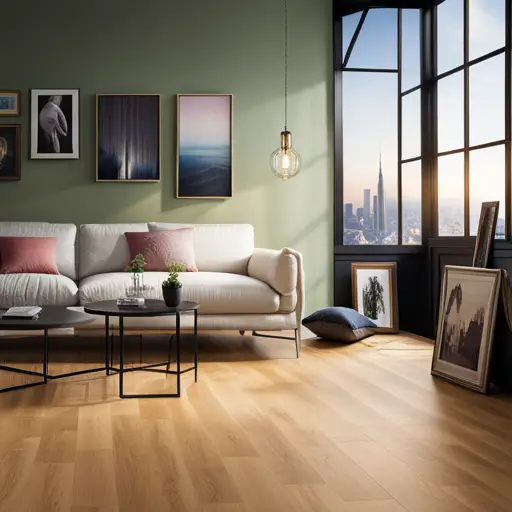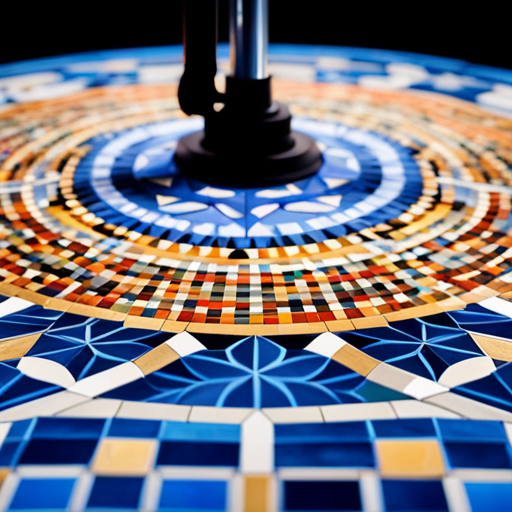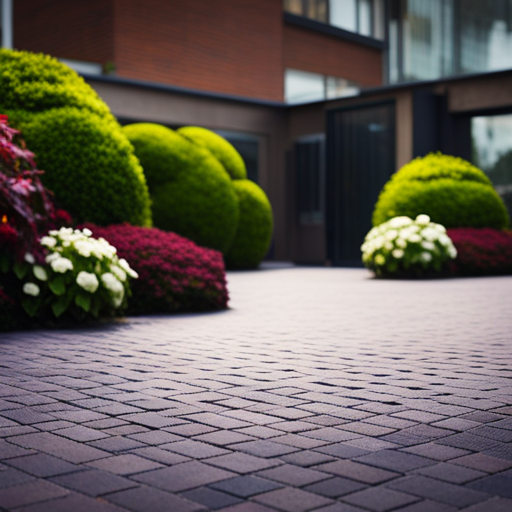The Resurgence of Linoleum in Contemporary Design

In an era marked by the constant pursuit of innovation and sustainability, an unexpected champion has emerged in the world of contemporary design: linoleum. Once regarded as a relic of the past, this versatile material has experienced a remarkable resurgence, captivating designers and homeowners alike with its rich history, modern applications, and eco-friendly benefits.
As we delve into the revival of linoleum, we uncover its enduring appeal and the innovative ways it is reshaping the design landscape.
History of Linoleum
The history of linoleum dates back to the mid-19th century when Frederick Walton patented the material’s production process. Originally, linoleum was created as a cost-effective alternative to expensive flooring materials. Its evolution can be traced to the industrialization era, where mass production techniques made it more accessible to the general public.
The production techniques of linoleum have undergone significant advancements over the years, leading to a revival of interest in this versatile material. One of the key factors contributing to its resurgence is the growing emphasis on sustainable materials in contemporary design. As environmental consciousness continues to shape consumer choices, linoleum’s eco-friendly composition and manufacturing processes have positioned it as a popular option in the design world.
Its revival is a testament to the enduring appeal of this durable and sustainable flooring solution. The historical journey of linoleum underscores its adaptability to changing trends and consumer preferences, laying a strong foundation for its modern applications and trends. With its rich history and sustainable qualities, linoleum has found renewed relevance in contemporary design.
Modern Applications and Trends
Linoleum has experienced a revival in modern design, finding its way into contemporary spaces with its versatility and durability. The use of linoleum has expanded beyond traditional flooring to include innovative applications in furniture, wall coverings, and even custom installations.
Additionally, contemporary color palettes and patterns have reinvigorated linoleum, offering designers and homeowners a wide array of options to create unique and stylish interiors.
Linoleum in Modern Designs
Resurgence in contemporary design has seen a notable increase in the use of linoleum in modern applications and trends. Designers and architects are increasingly turning to linoleum for its sustainability benefits and innovative applications. Its eco-friendly composition, made from natural materials like linseed oil, wood flour, and pine rosin, aligns with the growing demand for environmentally conscious design materials.
In modern designs, linoleum is being utilized in diverse ways, from flooring and wall coverings to furniture and decorative elements. Its versatility allows for creative and unique applications, contributing to its resurgence in contemporary design. Moreover, the material’s durability and low maintenance needs make it an attractive choice for high-traffic areas in commercial and residential spaces.
This resurgence is indicative of a shift towards sustainable and versatile materials in modern design, setting the stage for the exploration of contemporary color and patterns.
Contemporary Color and Patterns
Amid the resurgence of linoleum in contemporary design, the use of modern applications and trends has led to an exploration of contemporary color and patterns, reflecting a shift towards sustainable and versatile materials.
Color psychology plays a pivotal role in the design impact of linoleum. Designers are increasingly leveraging custom patterns to create unique and personalized spaces, catering to the individual preferences of clients. Moreover, there is a growing emphasis on incorporating current color trends into linoleum designs, aligning with the broader interior design landscape.
The contemporary color and pattern options for linoleum are vast, allowing for an array of creative possibilities to suit diverse aesthetics and design objectives. This trend signifies a departure from conventional design approaches, embracing innovation and sustainability in modern interior spaces.
Environmental Benefits
The production of linoleum offers significant environmental benefits due to its use of natural and renewable materials. Linseed oil, wood flour, cork dust, tree resins, and pigments are the primary components, making linoleum a renewable resource and an eco-friendly flooring option.
Here are the environmental benefits of linoleum:
-
Renewable Materials: Linoleum is made from renewable raw materials, such as linseed oil and wood flour, which can be replenished, reducing the reliance on finite resources.
-
Biodegradability: At the end of its long lifespan, linoleum flooring naturally decomposes, minimizing its environmental impact and reducing landfill waste.
-
Low VOC Emissions: Linoleum emits low levels of volatile organic compounds (VOCs), contributing to better indoor air quality and a healthier living environment.
-
Energy Efficient Production: The manufacturing process of linoleum consumes less energy compared to other flooring materials, leading to reduced carbon emissions and lower environmental impact.
These environmental benefits make linoleum a sustainable and environmentally conscious choice for contemporary design projects.
Now, let’s delve into the durability and maintenance aspects of linoleum flooring.
Durability and Maintenance
An essential factor to consider when evaluating linoleum for contemporary design projects is its remarkable durability and straightforward maintenance requirements. Linoleum’s long-term performance is exceptional, making it an ideal choice for high-traffic areas in both residential and commercial spaces. Its composition of natural materials, such as linseed oil, wood flour, and rosin, provides inherent strength and resilience, ensuring that it can withstand heavy use and maintain its appearance over time.
When it comes to maintenance, linoleum is relatively low-maintenance compared to other flooring options. Regular sweeping or vacuuming to remove dust and debris is usually sufficient. For more thorough cleaning, damp mopping with a neutral pH cleaner is recommended to preserve the floor’s finish. Additionally, linoleum’s surface can be periodically treated with a manufacturer-recommended polish to enhance its luster and protect it from wear.
These straightforward cleaning techniques contribute to the appeal of linoleum in contemporary design, as they align with the growing emphasis on sustainable and easy-to-maintain materials in interior spaces. With its exceptional durability and simple maintenance requirements, linoleum continues to be a preferred choice for modern design projects.
Design Versatility
Linoleum’s design versatility has evolved over time to meet the diverse aesthetic and functional needs of contemporary interior spaces. This resurgence in popularity can be attributed to its ability to adapt to various design styles, making it a sought-after choice for modern interiors.
Some of the reasons for its renewed appeal include:
-
Versatile Applications: Linoleum can be used in a wide range of settings, from residential spaces to commercial environments, due to its adaptability and durability.
-
Unique Patterns: The availability of an extensive array of colors, patterns, and designs allows for endless creative possibilities, enabling designers to craft unique and personalized spaces.
-
Sustainable Options: With a growing emphasis on environmentally friendly materials, linoleum’s eco-friendly composition appeals to eco-conscious consumers and designers.
-
Customization Potential: The ability to create custom designs and integrate linoleum with other materials provides a high degree of flexibility, catering to the individual preferences and requirements of different projects.
This adaptability and versatility make linoleum a compelling choice for contemporary design, offering both aesthetic appeal and functional benefits.
Installation and Cost Considerations
As the resurgence of linoleum in contemporary design continues to gain momentum, it’s essential to consider the installation techniques and cost-effective maintenance tips associated with this versatile flooring option.
Understanding the various installation methods for linoleum, including glue-down and click-lock systems, can significantly impact the overall aesthetic and longevity of the flooring.
Additionally, exploring cost-effective maintenance tips can provide valuable insights into the long-term affordability and durability of linoleum in modern design applications.
Linoleum Installation Techniques
Increasingly, designers and architects are turning to innovative linoleum installation techniques to achieve cost-effective and durable flooring solutions in contemporary design projects. Seamless installation and sustainable materials are key factors driving the resurgence of linoleum.
The following considerations are essential for achieving optimal results:
-
Precision Cutting: Utilizing advanced cutting techniques to ensure seamless and precise fitting of linoleum flooring.
-
Subfloor Preparation: Thoroughly assessing and preparing the subfloor to guarantee a smooth and stable base for the linoleum installation.
-
Adhesive Selection: Choosing high-quality adhesives suitable for linoleum to ensure long-lasting and secure installation.
-
Professional Installation: Engaging skilled professionals with expertise in linoleum installation techniques to achieve impeccable results.
These techniques not only enhance the aesthetics of the space but also contribute to the overall sustainability and longevity of the flooring.
Cost-Effective Maintenance Tips
Cost-effectiveness is a primary consideration when addressing maintenance for linoleum flooring in contemporary design projects. When it comes to long-term care, linoleum offers sustainability benefits, making it an attractive choice for eco-conscious designers. Additionally, implementing budget-friendly cleaning techniques ensures that the flooring remains in top condition without breaking the bank. Below is a table summarizing cost-effective maintenance tips for linoleum flooring:
| Maintenance Tips | Description | Benefits |
|---|---|---|
| Regular Sweeping | Sweep the floor regularly to remove dust | Prevents scratches |
| pH-Neutral Cleaners | Use mild cleaners to maintain shine | Cost-effective and safe |
| Avoid Harsh Chemicals | Refrain from using abrasive chemicals | Preserves floor longevity |
Tips for Incorporating Linoleum Into Your Design
Professionals frequently recommend incorporating linoleum into contemporary designs for its durability, eco-friendly nature, and versatile aesthetic appeal. When considering linoleum for your design projects, keep in mind the following tips:
-
Design Inspiration: Draw inspiration from the vibrant range of colors and patterns available in linoleum flooring to create unique and visually appealing spaces.
-
Creative Applications: Think beyond traditional flooring and consider using linoleum for creating custom wall art, furniture accents, or even statement ceilings to add a touch of creativity to your design.
-
Long-Term Benefits: Emphasize the long-term benefits of linoleum, such as its resilience to heavy foot traffic and its ability to withstand wear and tear, making it a practical choice for high-traffic areas in residential and commercial spaces.
-
Cost Effectiveness: Highlight the cost-effective nature of linoleum, as it offers a durable and low-maintenance flooring solution that can stand the test of time, providing value for money in the long run.
Frequently Asked Questions
Can Linoleum Be Used in Outdoor Spaces?
Yes, linoleum can be used in outdoor spaces. It offers outdoor durability, but installation challenges may arise due to environmental factors. Proper installation and maintenance are crucial for ensuring longevity and performance in outdoor applications.
Are There Any Health Concerns Associated With Linoleum Installation or Maintenance?
Health concerns related to linoleum installation include off-gassing of volatile organic compounds, requiring proper ventilation. Installation precautions involve ensuring a clean and dry subfloor and using low-VOC adhesives. According to a study, 90% of linoleum users reported improved indoor air quality.
How Does Linoleum Compare to Other Types of Flooring in Terms of Sound Insulation?
In terms of sound insulation, linoleum offers a notable advantage in comparison to other types of flooring. Its dense material properties contribute to superior sound absorption, providing a quieter environment. Additionally, linoleum is an environmentally friendly choice.
Can Linoleum Be Installed Over Existing Flooring, or Does It Need to Be Removed First?
Installing linoleum over existing flooring depends on the condition of the current surface. While it’s possible in some cases, removing the old flooring ensures better adhesion and longevity. Consider outdoor use, health concerns, sound insulation, cleaning, maintenance, and high traffic areas.
Are There Any Special Considerations for Cleaning and Maintaining Linoleum in High-Traffic Areas?
When considering cleaning techniques for linoleum in high-traffic areas, it’s essential to establish a regular maintenance schedule. Utilizing non-abrasive cleaners, avoiding excessive water, and promptly addressing spills can help preserve linoleum’s durability and appearance.
Conclusion
In conclusion, the resurgence of linoleum in contemporary design is a testament to its enduring appeal and versatility.
Despite its initial decline, linoleum has made a comeback in modern applications due to its environmental benefits, durability, and design versatility.
This once overlooked material has now become a popular choice for interior designers and homeowners alike, adding a touch of nostalgia and irony to the current trend-focused design landscape.

Rubin Everest, a seasoned expert in the world of flooring, brings a wealth of knowledge and passion to the surface. As the mind behind ebbow.com, Rubin is dedicated to sharing insights on the latest trends, innovative solutions, and expert advice in the realm of flooring. Whether you’re seeking practical tips for installation or design inspiration, Rubin Everest is your go-to source for all things flooring-related, making your journey to the perfect floor an informed and enjoyable experience.





